towing Lexus ES350 2017 Owner's Manuals
[x] Cancel search | Manufacturer: LEXUS, Model Year: 2017, Model line: ES350, Model: Lexus ES350 2017Pages: 584, PDF Size: 13.96 MB
Page 5 of 584
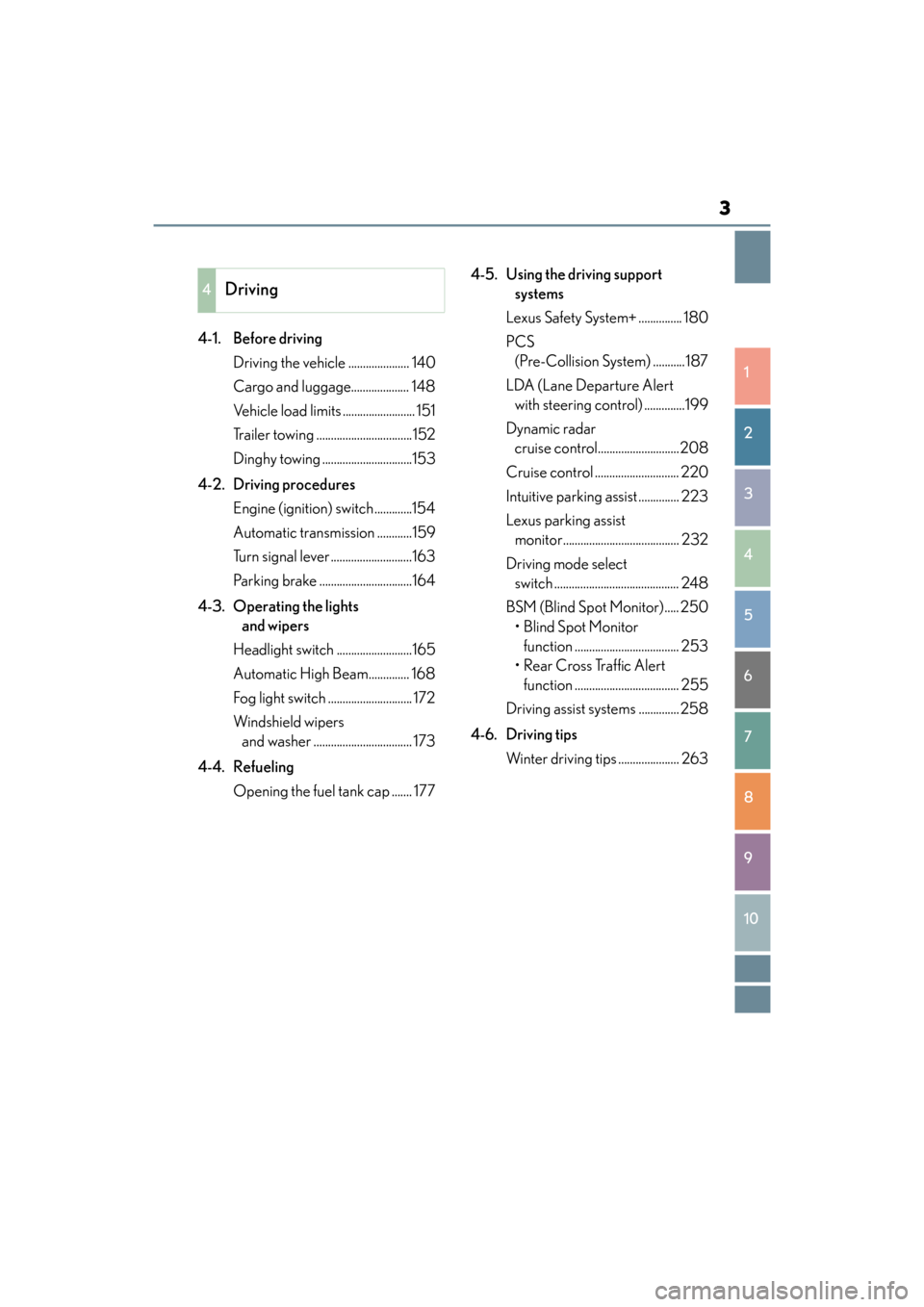
3
ES350_OM_OM33C68U_(U)
1
9 8
7 4 3
2
10
5
6
4-1. Before drivingDriving the vehicle ..................... 140
Cargo and luggage.................... 148
Vehicle load limits ......................... 151
Trailer towing .................................152
Dinghy towing ...............................153
4-2. Driving procedures Engine (ignition) switch .............154
Automatic transmission ............159
Turn signal lever ............................163
Parking brake ................................164
4-3. Operating the lights and wipers
Headlight switch ..........................165
Automatic High Beam.............. 168
Fog light switch ............................. 172
Windshield wipers and washer .................................. 173
4-4. Refueling Opening the fuel tank cap ....... 177 4-5. Using the driving support
systems
Lexus Safety System+ ............... 180
PCS (Pre-Collision System) ...........187
LDA (Lane Departure Alert with steering control) ..............199
Dynamic radar cruise control............................208
Cruise control ............................. 220
Intuitive parking assist .............. 223
Lexus parking assist monitor........................................ 232
Driving mode select switch ........................................... 248
BSM (Blind Spot Monitor)..... 250 • Blind Spot Monitor function .................................... 253
• Rear Cross Traffic Alert function .................................... 255
Driving assist systems .............. 258
4-6. Driving tips Winter driving tips ..................... 263
4Driving
Page 18 of 584
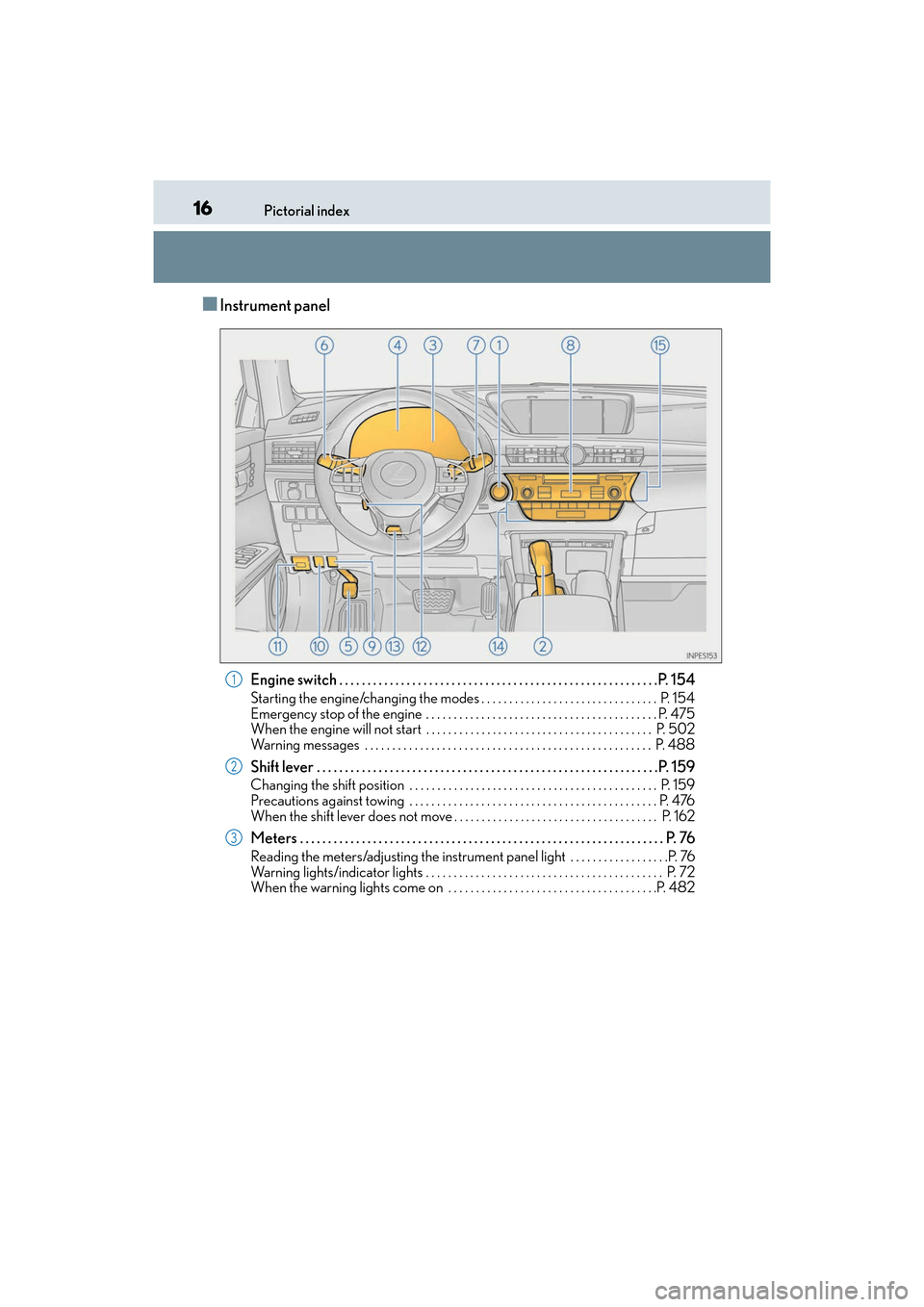
16Pictorial index
ES350_OM_OM33C68U_(U)
■Instrument panel
Engine switch . . . . . . . . . . . . . . . . . . . . . . . . . . . . . . . . . . . . . . . . . . . . . . . . . . . . . . . . . P. 1 5 4
Starting the engine/changing the modes . . . . . . . . . . . . . . . . . . . . . . . . . . . . . . . . P. 154
Emergency stop of the engine . . . . . . . . . . . . . . . . . . . . . . . . . . . . . . . . . . . . . . . . . . P. 475
When the engine will not start . . . . . . . . . . . . . . . . . . . . . . . . . . . . . . . . . . . . . . . . . P. 502
Warning messages . . . . . . . . . . . . . . . . . . . . . . . . . . . . . . . . . . . . . . . . . . . . . . . . . . . . P. 488
Shift lever . . . . . . . . . . . . . . . . . . . . . . . . . . . . . . . . . . . . . . . . . . . . . . . . . . . . . . . . . . . . .P. 159
Changing the shift position . . . . . . . . . . . . . . . . . . . . . . . . . . . . . . . . . . . . . . . . . . . . . P. 159
Precautions against towing . . . . . . . . . . . . . . . . . . . . . . . . . . . . . . . . . . . . . . . . . . . . . P. 476
When the shift lever does not move . . . . . . . . . . . . . . . . . . . . . . . . . . . . . . . . . . . . . P. 162
Meters . . . . . . . . . . . . . . . . . . . . . . . . . . . . . . . . . . . . . . . . . . . . . . . . . . . . . . . . . . . . . . . . . P. 76
Reading the meters/adjusting the instrument panel light . . . . . . . . . . . . . . . . . .P. 76
Warning lights/indicator lights . . . . . . . . . . . . . . . . . . . . . . . . . . . . . . . . . . . . . . . . . . . P. 72
When the warning lights come on . . . . . . . . . . . . . . . . . . . . . . . . . . . . . . . . . . . . . .P. 482
1
2
3
Page 141 of 584
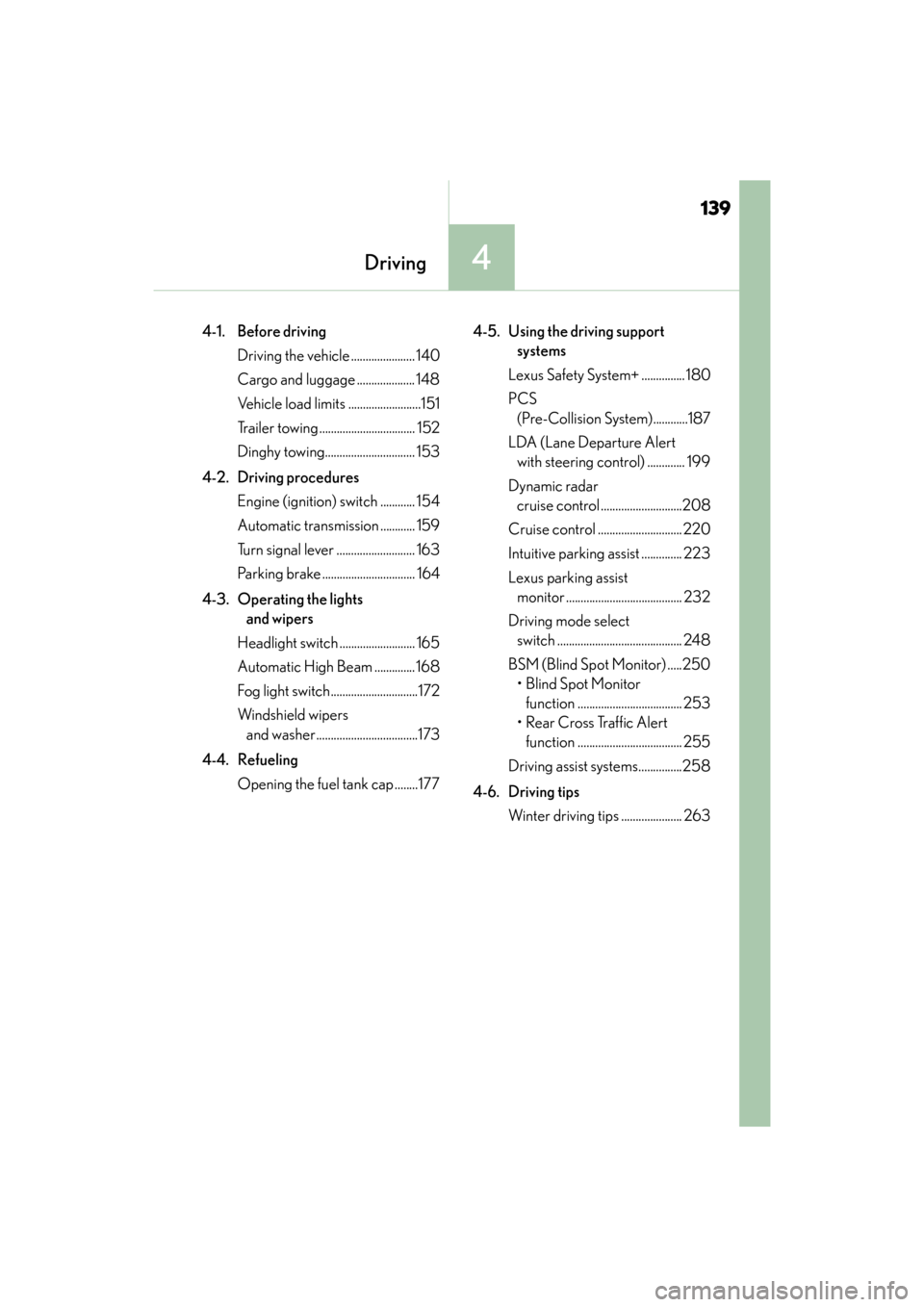
139
ES350_OM_OM33C68U_(U)
4Driving
4-1. Before drivingDriving the vehicle ...................... 140
Cargo and luggage .................... 148
Vehicle load limits .........................151
Trailer towing ................................. 152
Dinghy towing............................... 153
4-2. Driving procedures Engine (ignition) switch ............ 154
Automatic transmission ............ 159
Turn signal lever ........................... 163
Parking brake ................................ 164
4-3. Operating the lights and wipers
Headlight switch .......................... 165
Automatic High Beam .............. 168
Fog light switch..............................172
Windshield wipers and washer...................................173
4-4. Refueling Opening the fuel tank cap ........177 4-5. Using the driving support
systems
Lexus Safety System+ ............... 180
PCS (Pre-Collision System)............187
LDA (Lane Departure Alert with steering control) ............. 199
Dynamic radar cruise control ............................208
Cruise control ............................. 220
Intuitive parking assist .............. 223
Lexus parking assist monitor ........................................ 232
Driving mode select switch ........................................... 248
BSM (Blind Spot Monitor) .....250 •Blind Spot Monitor function .................................... 253
• Rear Cross Traffic Alert function .................................... 255
Driving assist systems...............258
4-6. Driving tips Winter driving tips ..................... 263
Page 150 of 584
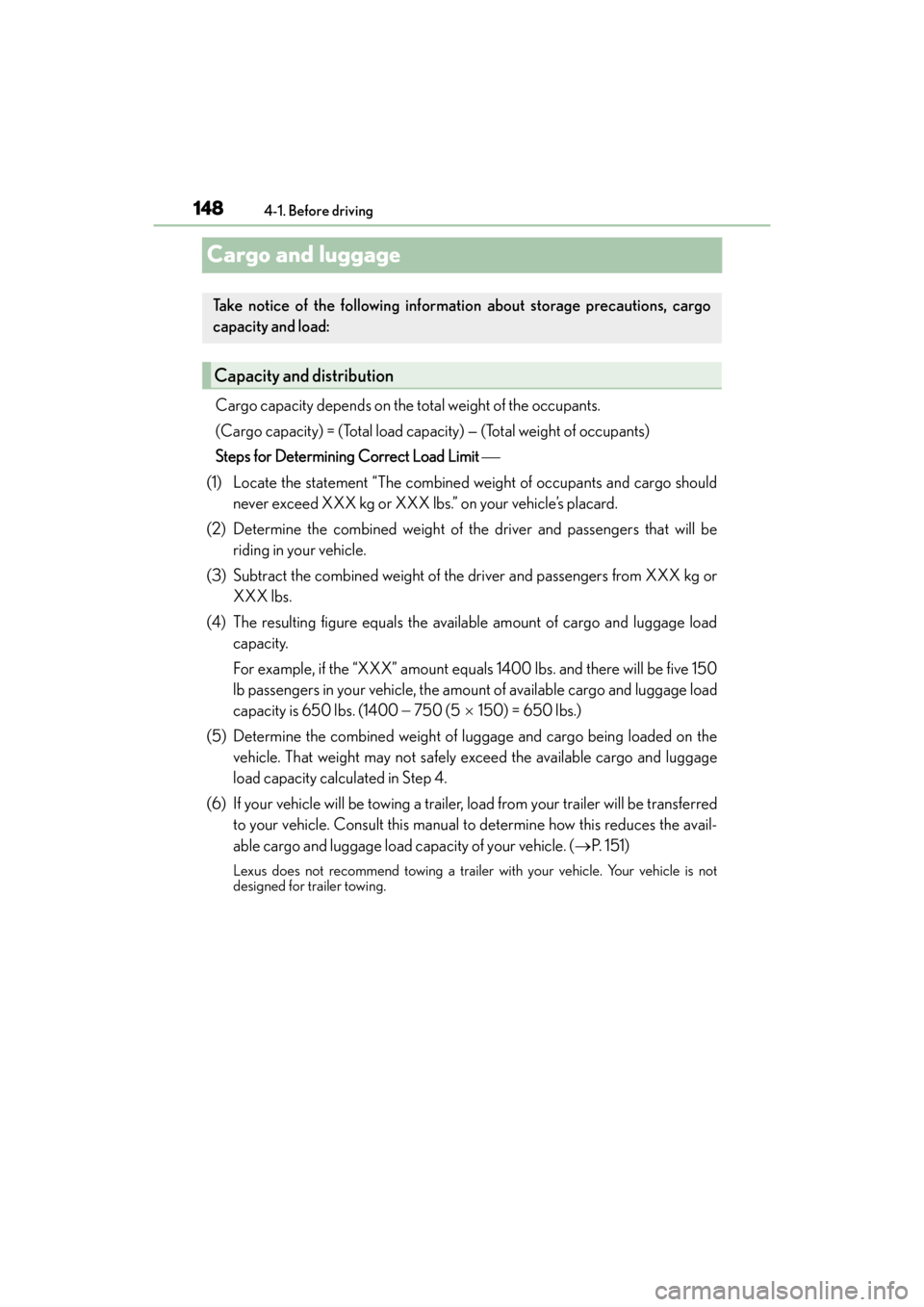
148
ES350_OM_OM33C68U_(U)4-1. Before driving
Cargo and luggage
Cargo capacity depends on the total weight of the occupants.
(Cargo capacity) = (Total load capacity) — (Total weight of occupants)
Steps for Determining Correct Load Limit
(1) Locate the statement “The combined weight of occupants and cargo should never exceed XXX kg or XXX lbs.” on your vehicle’s placard.
(2) Determine the combined weight of the driver and passengers that will be riding in your vehicle.
(3) Subtract the combined weight of the driver and passengers from XXX kg or XXX lbs.
(4) The resulting figure equals the available amount of cargo and luggage load capacity.
For example, if the “XXX” amount equals 1400 lbs. and there will be five 150
lb passengers in your vehicle, the amount of available cargo and luggage load
capacity is 650 lbs. (1400 − 750 (5 × 150) = 650 lbs.)
(5) Determine the combined weight of luggage and cargo being loaded on the vehicle. That weight may not safely exceed the available cargo and luggage
load capacity calculated in Step 4.
(6) If your vehicle will be towing a trailer, load from your trailer will be transferred to your vehicle. Consult this manual to determine how this reduces the avail-
able cargo and luggage load capacity of your vehicle. ( →P. 1 5 1 )
Lexus does not recommend towing a trailer with your vehicle. Your vehicle is not
designed for trailer towing.
Take notice of the following information about storage precautions, cargo
capacity and load:
Capacity and distribution
Page 153 of 584
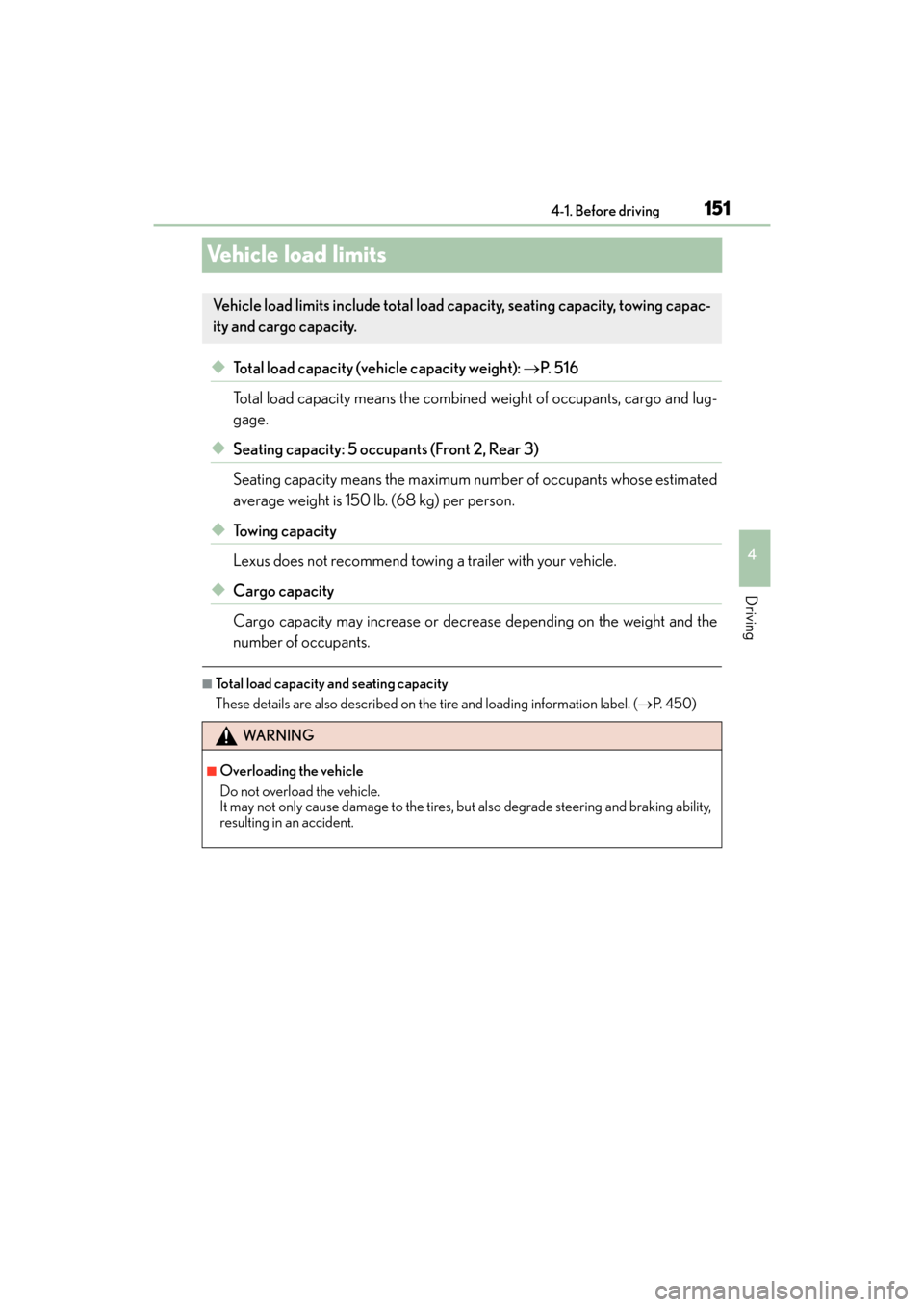
151
ES350_OM_OM33C68U_(U)4-1. Before driving
4
Driving
Vehicle load limits
◆Total load capacity (vehicle capacity weight):
→P. 5 1 6
Total load capacity means the combined weight of occupants, cargo and lug-
gage.
◆Seating capacity: 5 occupants (Front 2, Rear 3)
Seating capacity means the maximum number of occupants whose estimated
average weight is 150 lb. (68 kg) per person.
◆Towing capacity
Lexus does not recommend towing a trailer with your vehicle.
◆Cargo capacity
Cargo capacity may increase or decrease depending on the weight and the
number of occupants.
■Total load capacity and seating capacity
These details are also described on the tire and loading information label. (→P. 4 5 0 )
Vehicle load limits include total load capacity, seating capacity, towing capac-
ity and cargo capacity.
WA R N I N G
■Overloading the vehicle
Do not overload the vehicle.
It may not only cause damage to the tires, but also degrade steering and braking ability,
resulting in an accident.
Page 154 of 584

152
ES350_OM_OM33C68U_(U)4-1. Before driving
Trailer towing
Lexus does not recommend towing a trailer with your vehicle. Lexus also does
not recommend the installation of a tow hitch or the use of a tow hitch carrier
for a wheelchair, scooter, bicycle, etc. Your vehicle is not designed for trailer
towing or for the use of tow hitch mounted carriers.
Page 155 of 584
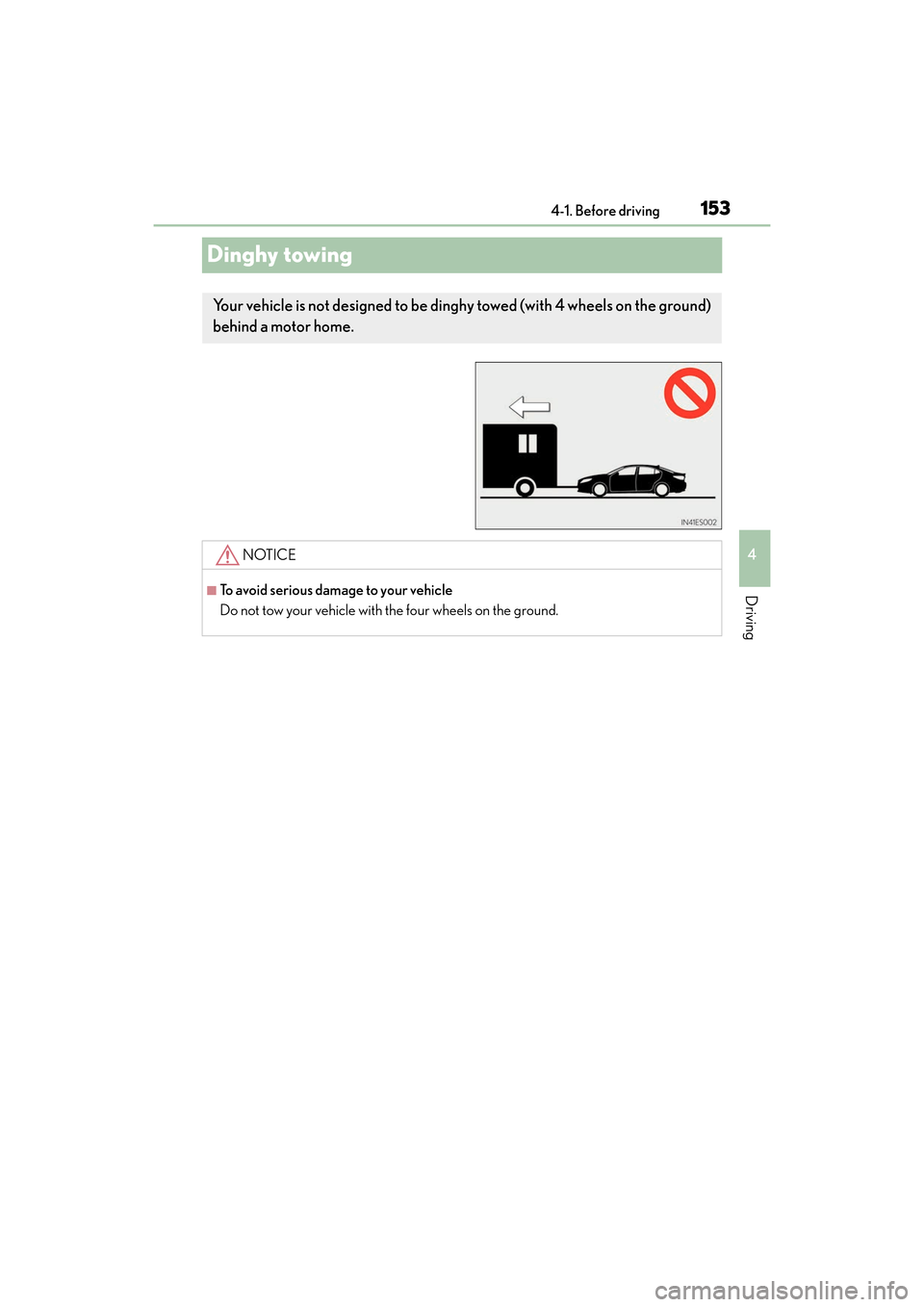
153
ES350_OM_OM33C68U_(U)4-1. Before driving
4
Driving
Dinghy towing
Your vehicle is not designed to be ding
hy towed (with 4 wheels on the ground)
behind a motor home.
NOTICE
■To avoid serious damage to your vehicle
Do not tow your vehicle with the four wheels on the ground.
Page 191 of 584
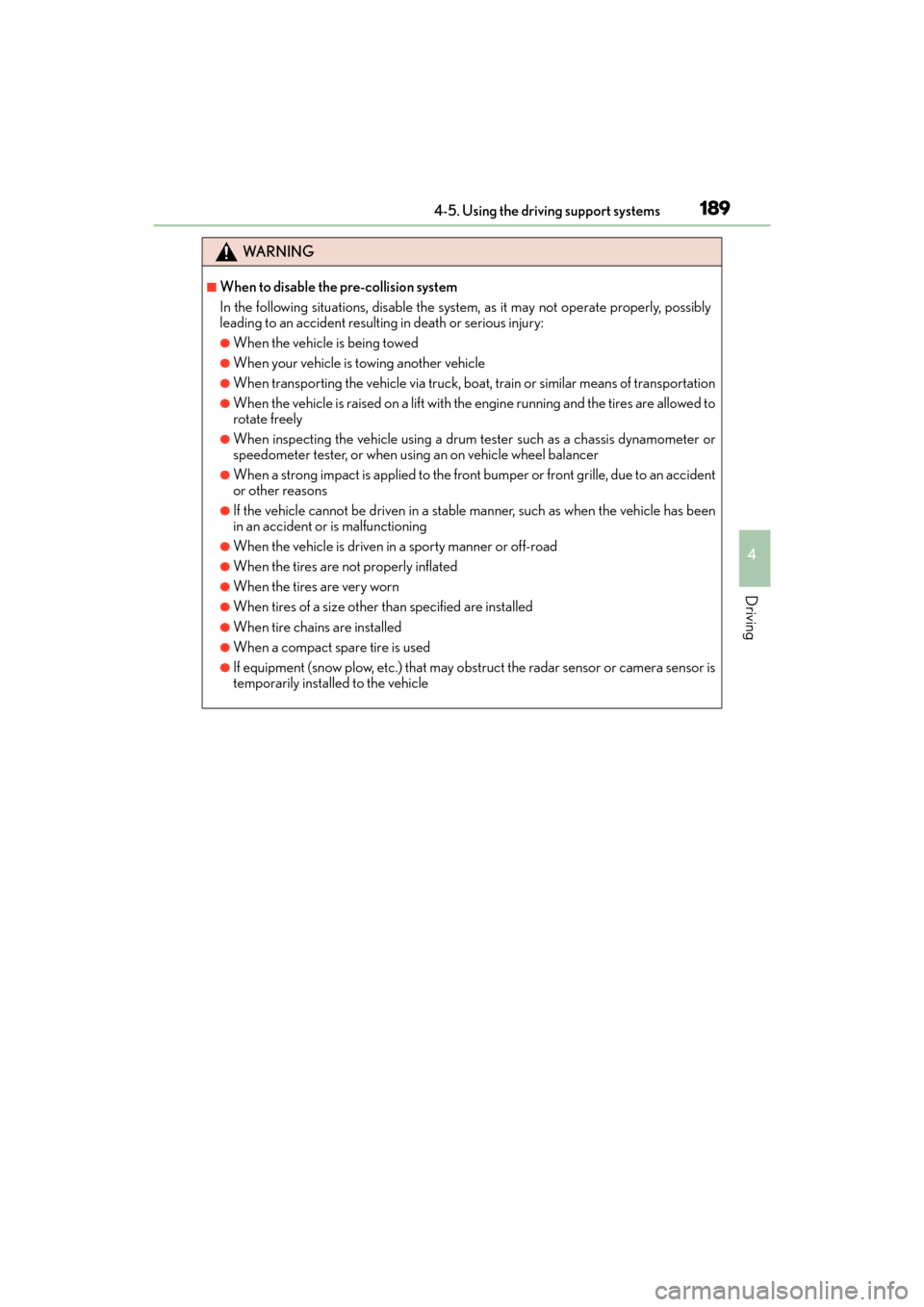
ES350_OM_OM33C68U_(U)
1894-5. Using the driving support systems
4
Driving
WA R N I N G
■When to disable the pre-collision system
In the following situations, disable the system, as it may not operate properly, possibly
leading to an accident resulting in death or serious injury:
●When the vehicle is being towed
●When your vehicle is towing another vehicle
●When transporting the vehicle via truck, boat, train or similar means of transportation
●When the vehicle is raised on a lift with the engine running and the tires are allowed to
rotate freely
●When inspecting the vehicle using a drum tester such as a chassis dynamometer or
speedometer tester, or when using an on vehicle wheel balancer
●When a strong impact is applied to the fr ont bumper or front grille, due to an accident
or other reasons
●If the vehicle cannot be driven in a stable manner, such as when the vehicle has been
in an accident or is malfunctioning
●When the vehicle is driven in a sporty manner or off-road
●When the tires are not properly inflated
●When the tires are very worn
●When tires of a size other than specified are installed
●When tire chains are installed
●When a compact spare tire is used
●If equipment (snow plow, etc.) that may obstruct the radar sensor or camera sensor is
temporarily installed to the vehicle
Page 203 of 584
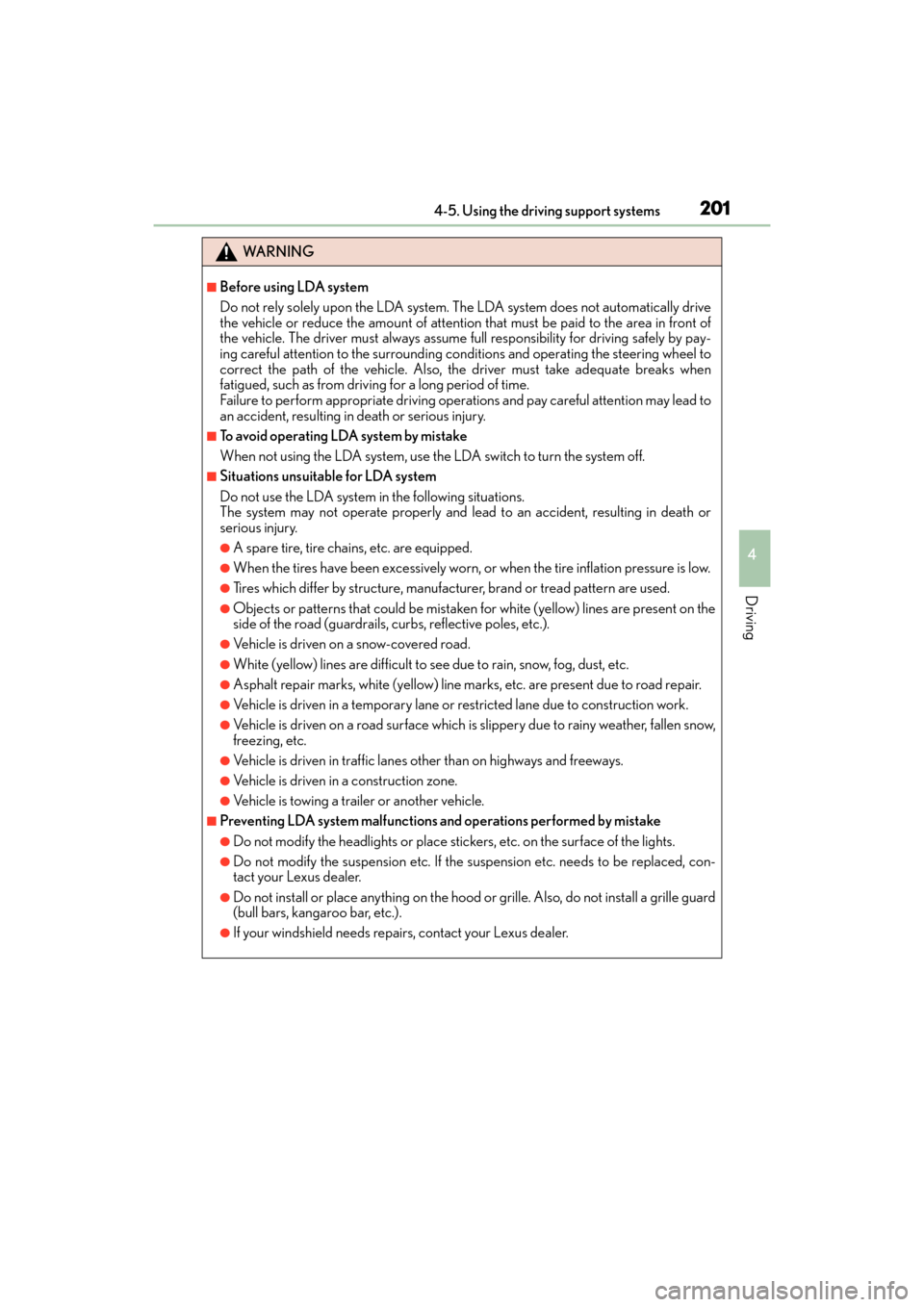
ES350_OM_OM33C68U_(U)
2014-5. Using the driving support systems
4
Driving
WA R N I N G
■Before using LDA system
Do not rely solely upon the LDA system. The LDA system does not automatically drive
the vehicle or reduce the amount of attention that must be paid to the area in front of
the vehicle. The driver must always assume full responsibility for driving safely by pay-
ing careful attention to the surrounding cond itions and operating the steering wheel to
correct the path of the vehicle. Also, the driver must take adequate breaks when
fatigued, such as from driving for a long period of time.
Failure to perform appropriate driving operat ions and pay careful attention may lead to
an accident, resulting in death or serious injury.
■To avoid operating LDA system by mistake
When not using the LDA system, use the LDA switch to turn the system off.
■Situations unsuitable for LDA system
Do not use the LDA system in the following situations.
The system may not operate properly and lead to an accident, resulting in death or
serious injury.
●A spare tire, tire chains, etc. are equipped.
●When the tires have been excessively worn, or when the tire inflation pressure is low.
●Tires which differ by structure, manufacturer, brand or tread pattern are used.
●Objects or patterns that could be mistaken for white (yellow) lines are present on the
side of the road (guardrails, curbs, reflective poles, etc.).
●Vehicle is driven on a snow-covered road.
●White (yellow) lines are difficult to see due to rain, snow, fog, dust, etc.
●Asphalt repair marks, white (yellow) line marks, etc. are present due to road repair.
●Vehicle is driven in a temporary lane or restricted lane due to construction work.
●Vehicle is driven on a road surface which is slippery due to rainy weather, fallen snow,
freezing, etc.
●Vehicle is driven in traffic lanes other than on highways and freeways.
●Vehicle is driven in a construction zone.
●Vehicle is towing a trailer or another vehicle.
■Preventing LDA system malfunctions and operations performed by mistake
●Do not modify the headlights or place stickers, etc. on the surface of the lights.
●Do not modify the suspension etc. If the suspension etc. needs to be replaced, con-
tact your Lexus dealer.
●Do not install or place anything on the hood or grille. Also, do not install a grille guard
(bull bars, kangaroo bar, etc.).
●If your windshield needs repairs, contact your Lexus dealer.
Page 212 of 584
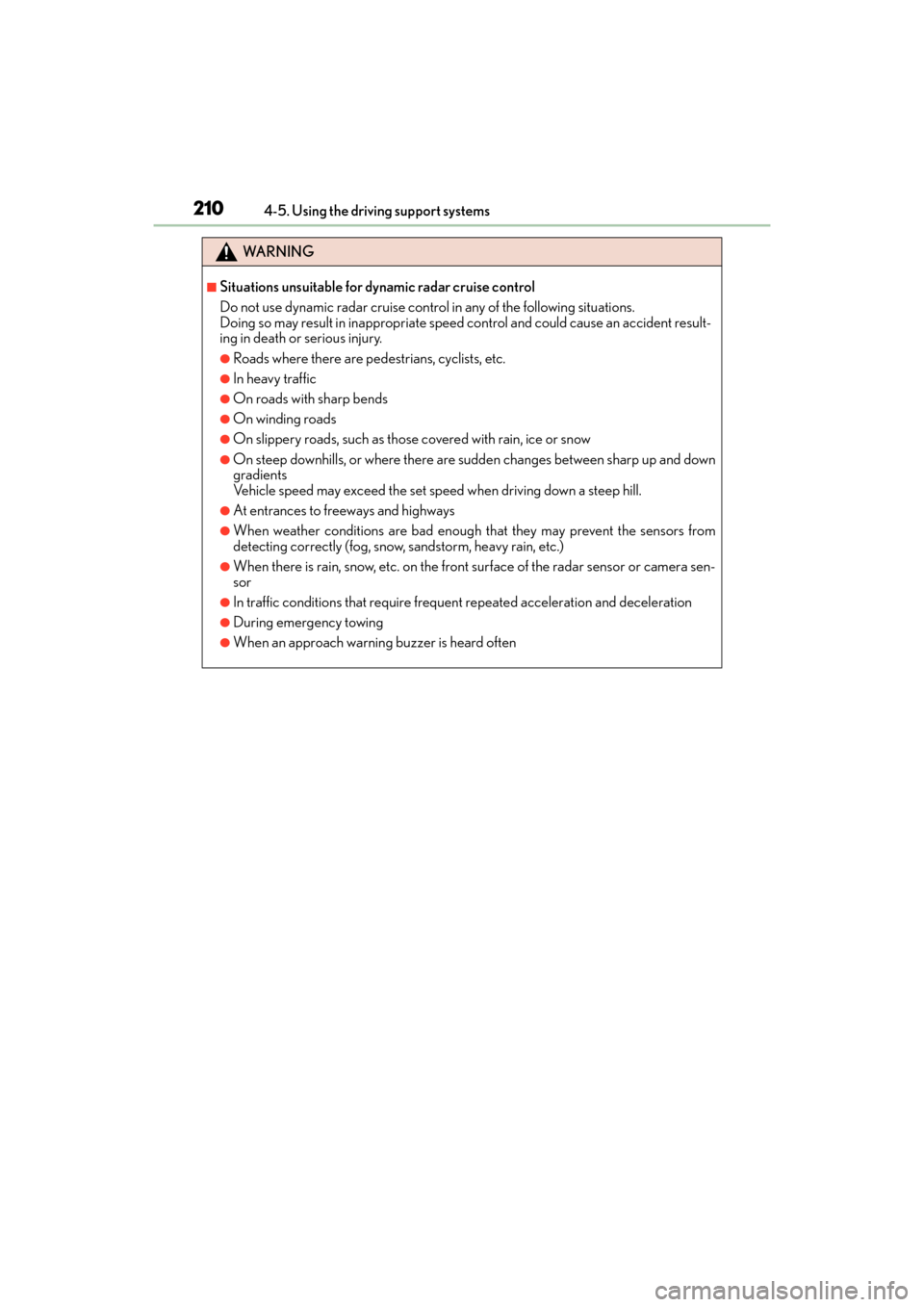
210
ES350_OM_OM33C68U_(U)4-5. Using the driving support systems
WA R N I N G
■Situations unsuitable for dynamic radar cruise control
Do not use dynamic radar cruise control in any of the following situations.
Doing so may result in inappropriate speed control and could cause an accident result-
ing in death or serious injury.
●Roads where there are pedestrians, cyclists, etc.
●In heavy traffic
●On roads with sharp bends
●On winding roads
●On slippery roads, such as those covered with rain, ice or snow
●On steep downhills, or where there are su
dden changes between sharp up and down
gradients
Vehicle speed may exceed the set speed when driving down a steep hill.
●At entrances to freeways and highways
●When weather conditions are bad enough that they may prevent the sensors from
detecting correctly (fog, snow, sandstorm, heavy rain, etc.)
●When there is rain, snow, etc. on the front surface of the radar sensor or camera sen-
sor
●In traffic conditions that require frequent repeated acceleration and deceleration
●During emergency towing
●When an approach warning buzzer is heard often